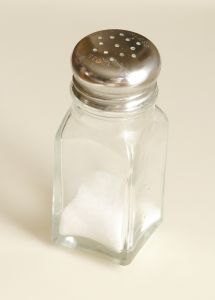 The updated Dietary Guidelines for Americans have finally been released and although they are a month late, and really not much different from the 2005 version, they address some vital concerns, including heart disease. The late release of the new guidelines serves as a strong foundation for this year’s American Heart Month. With an emphasis on reduced sodium intake as a key recommendation, the Dietary Guidelines acknowledge the importance of heart health among Americans.
The updated Dietary Guidelines for Americans have finally been released and although they are a month late, and really not much different from the 2005 version, they address some vital concerns, including heart disease. The late release of the new guidelines serves as a strong foundation for this year’s American Heart Month. With an emphasis on reduced sodium intake as a key recommendation, the Dietary Guidelines acknowledge the importance of heart health among Americans.
On average, the typical American diet includes 3,800 mg of sodium a day. That’s a far jump from the recommended 2,300 mg and an even further jump from the reduced intake of 1,500 mg for “persons who are 51 and older and those of any age who are African American or have hypertension, diabetes, or chronic kidney disease.” Although it would do good for everyone to lean towards the more modest number of 1,500 mg, it’s essential for about half of the population. There are many ways you can reduce the amount of sodium in your diet:
- Start small so that you aren’t shocked by the difference. Salt, like many other things that we become accustomed to, is hard to quit cold-turkey.
- Read all nutrition labels and ingredient lists.
- Avoid buying food that’s highly processed.
- Look for low-sodium and no-salt alternatives to your favorite products. Heinz released a no-salt ketchup last year made with AlsoSalt, a salt-alternative.
- Limit the amount of salt you use during meal preparation. Try the finished product first and then salt to taste.
- Use plenty of herbs and spices instead of salt. Besides cutting back on sodium, you will be adding antioxidants and other powerful nutrients to your food!
The new guidelines remind us that there are also other ways to nurture your cardiovascular system, including regular exercise. We’re also prompted to steer clear of saturated and trans fats. The Dietary Guidelines recommend “replacing them with monounsaturated and polyunsaturated fatty acids.” It’s also mentioned that we should “consume less than 300 mg per day of dietary cholesterol.”
Heart disease remains the leading cause of U.S. deaths. According to the CDC, “every 25 seconds, an American will have a coronary event.” The USDA and Department of Health and Human Services have done their part by providing us with the guidelines we need to improve our cardiovascular health. Now it’s our turn to follow those recommendations and there’s no better time to start then February, American Heart Month.
Also Read:
